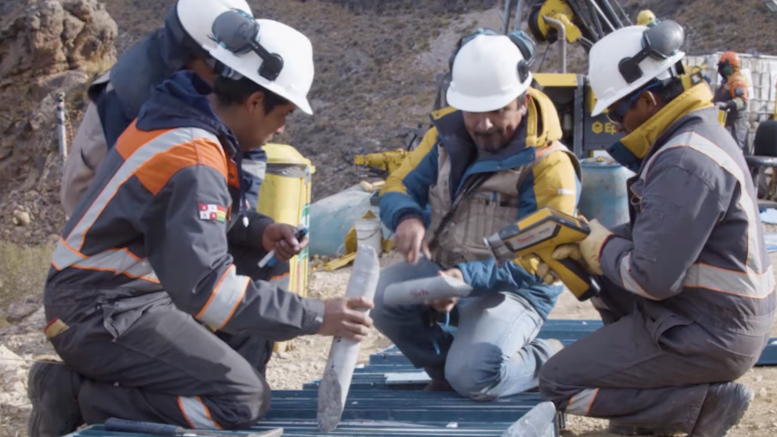New Pacific Metals (TSX: NUAG; NYSE-AM: NEWP) says its first resource estimate for the Carangas silver-gold project in Bolivia makes it notable worldwide.
The report released on Tuesday divides Carangas into three zones holding a total of 214.9 million indicated tonnes containing 205.3 million oz. silver, 1.6 million oz. gold, 1.4 billion lb. lead, 2.7 million lb. zinc and 112.6 million lb. copper, or collectively 559.8 million oz.silver equivalent.
The total inferred resource is 45 million tonnes containing 47.7 million oz. silver, 217,700 oz. gold, 297.9 million lb. lead, 533.7 million lb. zinc, and 16.8 million lb. copper, or collectively 109.8 million oz. silver equivalent.
There is also gold-dominant mineralization below the resource area comparable in size and grade that may be assessed for underground mining, Vancouver-based New Pacific said in a release. And it said electromagnetic surveys this year found anomalies over 29 sq. km of the Carangas site, which is about 400 km south of La Paz.
“These anomalies may host mineralization similar to what has been drilled thus far, underscoring the potential for mineral resource growth through additional drilling campaigns,” the company said. “Carangas is a globally significant silver-gold polymetallic discovery.”
The company is holding a webcast to discuss the resource estimate on Wed. Sept. 6 at 11 a.m. Eastern Time.
Caldera system
Shares in New Pacific Metals closed 3.7% lower at $3.36 apiece on Tuesday in Toronto as the wider market dropped, valuing the company at $527.9 million. They’ve traded in a 52-week range of $2.48 to $4.14.
Carangas’ mineralization formed with heat in a volcanic caldera system to produce an upper zone rich in silver, a middle zone dominated by zinc and lead, and a lower zone with a higher concentration of gold.
The upper silver zone has 119.2 million indicated tonnes grading 44.7 grams silver per tonne, 0.1 gram gold, 0.3% lead. 0.7% zinc and 0.01% copper for 171.2 million oz. silver, 216,400 oz. gold, 916.5 million lb. lead, 1.7 billion lb. zinc and 34.5 million lb. copper.
The middle zinc zone holds 43.4 million indicated tonnes grading 10.8 grams silver, 0.1 gram gold, 0.4% lead, 0.8% zinc and 0.01% copper for 15 million oz. silver, 77,400 oz. gold, 343.6 million lb. lead, 739.4 million lb. zinc and 13.7 million lb. copper.
The lower gold zone has 52.3 million indicated tonnes grading 11.4 grams silver, 0.8 gram gold, 0.2% lead, 0.2% zinc and 0.06% copper for 19.1 million tonnes silver, 1.3 million oz. gold, 184.7 million lb. lead, 184.7 million lb. zinc and 64.4 million lb. copper.
Mineralization starts at or near surface allowing for open-pit mining with an average stripping ratio of about 1.8 tonnes waste rock per 1 tonne of resource, New Pacific said. Metallurgical test work indicates recoveries of up to 90% for silver and 98% for gold based on a combination of flotation and cyanide leaching, it said.
Top assay
Drill results released on Feb. 21 at Carangas had that week’s highest grade x width globally, according to assays compiled by The Northern Miner. Drill hole DCAr0096 cut 523.9 metres grading 1.2 grams gold from 333.5 metres depth for a grade x width of 650.
New Pacific has drilled more than 80,000 metres in 189 holes since 2021. The assay results indicate a thick zone of gold mineralization occurs beneath a shallow silver horizon measuring approximately 1,000 metres long, 800 metres wide and up to 200 metres thick, it said.
Also in Bolivia, the company is advancing the Silver Sand silver project about km 560 km southeast of La Paz. It has an after-tax net present value of US$726 million at a 5% discount rate with an internal return rate of 39%, according to a preliminary economic assessment issued in February. The study envisions total silver production of 171 million oz. over a 14-year mine life. The largest capital spending would be US$186 million for a mill.
“As a jurisdiction, Bolivia remains largely unexplored with modest exploration over the past 20 years,” BMO Capital Markets wrote in a note in March after a presentation by New Pacific CEO Andrew Williams to a conference run by the bank. “However, the geology remains promising with the continuation of mineralized trends extending from Chile, Peru and Argentina. Approximately 30% of the national economy is reliant on the mining industry.”


Be the first to comment on "New Pacific’s Carangas in Bolivia holds 200M oz silver, plus gold and base metals"